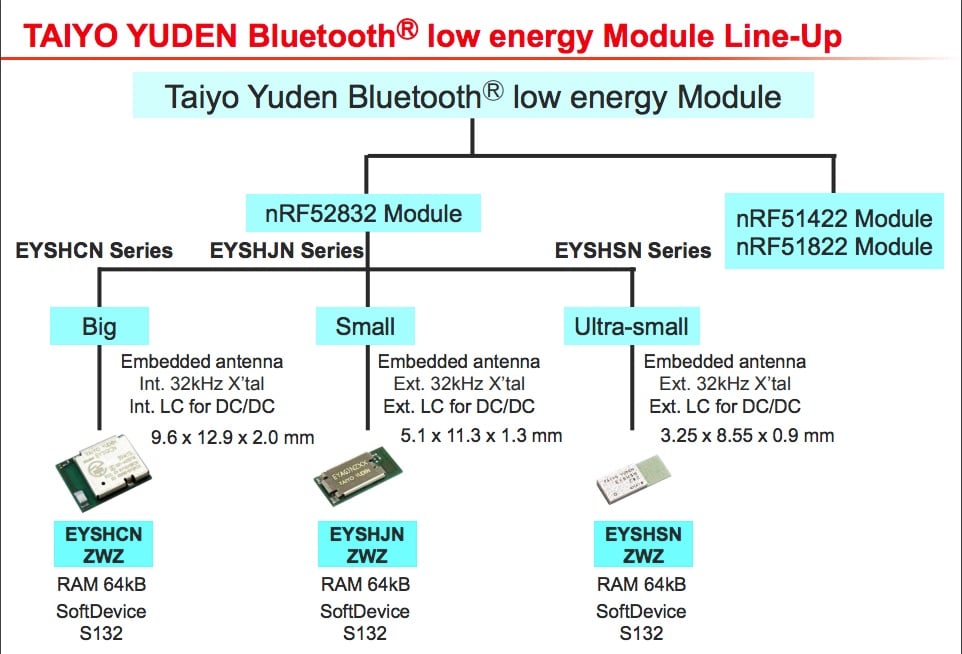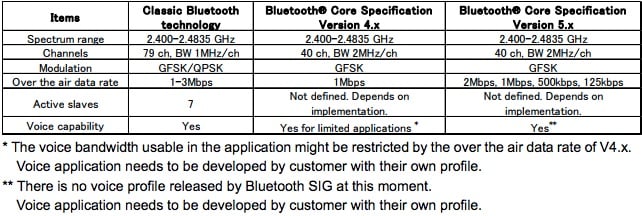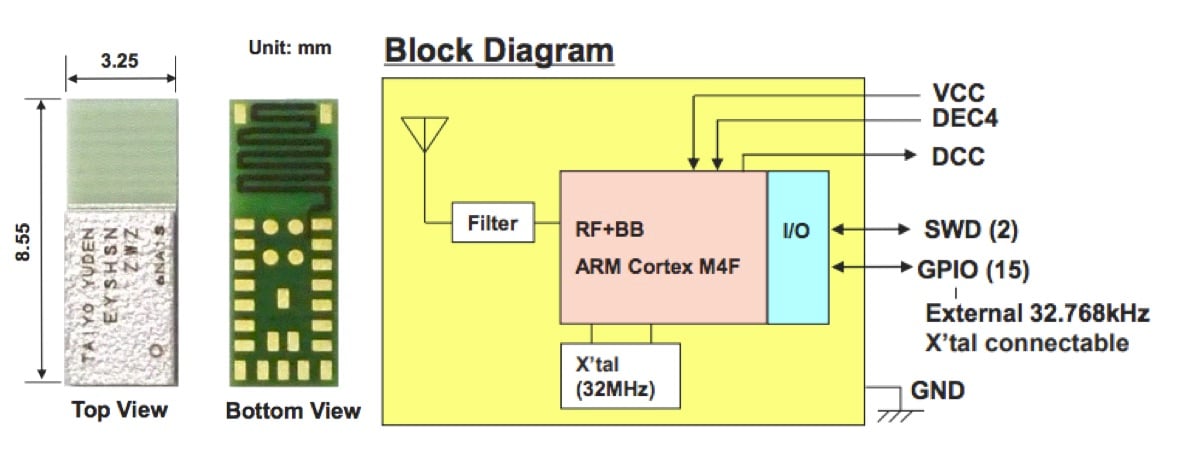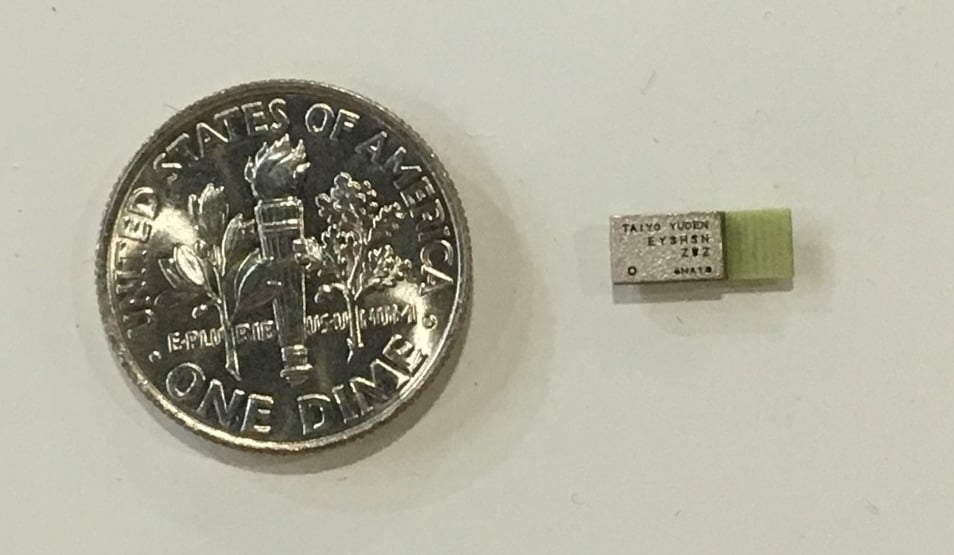TAIYO YUDEN’s EYSHSNZWZ: ‘The World’s Smallest Bluetooth Module’
TAIYO YUDEN showcased three Bluetooth low energy modules at CES 2018, one of which is less than a millimeter thick.
Take a closer look TAIYO YUDEN’s smallest BLE module, specifically sized for smart wristbands, pens, thermometers, and other small form factors.
Bluetooth 5 came into its most recent form in December of 2016. Soon after, TAIYO YUDEN released their line of Bluetooth low-energy modules, all three of which use Nordic Semiconductor’s nRF52832 chip. TAIYO YUDEN spotlighted this series of modules at CES 2018 in Las Vegas, Nevada.
Ranging in size from smaller than a coin to slightly larger than a micro SD card, these modules—the EYSHSNZWZ, the EYSHCNZWZ, and the EYSHJNZWZ—are designed with IoT devices in mind. According to TAIYO YUDEN, the total shipment of Bluetooth-enabled devices as such is projected to reach 4.6 billion units in 2018.

TAIYO YUDEN's series of nRF52832 Bluetooth low energy modules. Image courtesy of TAIYO YUDEN.
What Can Bluetooth 5 Offer?
In an industry article on All About Circuits, Ferdie Brillantes, a wireless module field applications engineer at TAIYO YUDEN, delved into the new features of Bluetooth 5, which the nRF52832 family utilizes. In essence, these modules sport double the Msps (megasamples per second) rate and frequency deviation of their version 4.2 predecessors.
“This provides twice the bandwidth of v4.2 without reducing the number of Bluetooth low energy channels,” Brillantes writes. “The bandwidth still fits within the 2MHz channel spacing used in Bluetooth low energy.”
According to TAIYO YUDEN’s Bluetooth low energy FAQ sheet, Bluetooth 5 offers twice the speed, four times the range, and eight times the broadcast capacity of version 4.2. However, because the “longer range is achieved by increasing receiver sensitivity through error control coding, which reduces the data rate,” these modules cannot reach both their increased speed and range simultaneously. TAIYO YUDEN suggests designers need to identify which is most important to their project—range or data rate—and embrace that particular feature.

This chart compares classic Bluetooth technology to Bluetooth 4.x and 5.x low energy technology. Image courtesy of TAIYO YUDEN.
How Low is Low Energy?
Bluetooth low energy (commonly referred to as BLE) was standardized in Bluetooth 4 in 2010. According to TAIYO YUDEN, it uses the same frequency as normal Bluetooth, 2.4 GHz, but these modules are not compatible with classic Bluetooth.
Bluetooth low energy is generally used for IoT devices or devices that need to last for several months on a small coin cell battery. These small devices are generally compatible with multiple fitness and healthcare devices, as well as most forms of smart home technology.
“The power consumption completely depends on the use case and the operational conditions,” TAIYO YUDEN says in their FAQ sheet. “In scenarios where battery consumption is kept to an absolute minimum, it should be possible to achieve a year or more of battery life within a coin cell battery.”
TAIYO YUDEN Bluetooth 4 low energy modules operate at 1 Mbps while their Bluetooth 5 modules can operate at up to 2 Mbps. But, in order to achieve the aforementioned yearlong battery life, it is likely that these speeds would also have to be kept to a minimum.

The measurements and a schematic of the EYSHSNZWZ. Images courtesy of TAIYO YUDEN.
A Closer Look at the EYSHSNZWZ
One of the stars of TAIYO YUDEN’s Bluetooth 5 low energy modules is the EYSHSNZWZ. Sporting an integrated system clock, an ARM Cortex M4F 32-bit processor, 512 kB of flash, and 64 kB of RAM, this module comes in at 3.25 by 8.55 by 0.9 millimeters.
“The EYSHSNZWZ employs TAIYO YUDEN's original cutting-edge advanced packaging structure, ‘Shield Mold’, and an embedded high-performance printed PCB antenna,” Mikio Aoki, a TAIYO YUDEN project manager in the integrated module business division, told AAC.
In an August 2017 press release, TAIYO YUDEN called this particular component “the world's smallest Bluetooth® module with an integrated antenna.” This module is 48% smaller than their existing modules for small IoT devices. The company says it’s roughly one-third the size of the EYSHJNZXZ, TAIYO YUDEN’s smallest module from their conventional lineup. Six of them can fit on a dime.
The EYSHSNZWZ, like the other modules in its series, has two software options. Purchased as a basic module, it comes without preprogrammed applications, letting designers host their own application directly on the module without an external host processor. It also comes as a software embedded module, with TAIYO YUDEN’s application preprogrammed on the module. TAIYO YUDEN suggests this option for any “simple cable replacement” functions.

The EYSHSNZWZ is smaller than a dime. Photo by Karissa Manske.
The Future of TAIYO YUDEN’s Small Modules
The EYSHSNZWZ is obviously quite small, and according to TAIYO YUDEN, its applications can range from heart rate monitors to smart glasses.
“A very small and thin module is desired for small and slim IoT devices, such as temples of smart glass, smart chopsticks, smart pens, smart rings, and so on,” Aoki said.
Among these modules of the future is TAIYO YUDEN’s newest module, coming to mass production in early 2018, the EYSLCNZWW. “This is the latest nRF52 series BT5 module,” Aoki said. It “targets relatively simple Bluetooth applications,” compared to those the EYSHCNZWZ might take on.
“The EYSLCNZWW utilizes Nordic Semiconductor's nRF52810 chip that has low power consumption and 2Mbps higher throughput, and it has optimized memory and function for simple IoT devices,” Aoki added.
The EYSLCNZWW may not be as small as the EYSHSNZWZ—it’s 9.6 by 12.9 by 2.0 millimeters—but TAIYO YUDEN believes it will be useful in healthcare and fitness applications, as well as in other mobile accessories and remote controllers. TAIYO YUDEN is, however, planning on releasing an "ultra-small version" of the nRF53810 module for mass production in June of 2018. The company said this version will, in fact, be as small as the EYSHSNZWZ.
These new modules are on-trend. As more and more products, specifically smaller and smaller products, transition into "smart" territory, so too must their Bluetooth modules.
Do you have experience working with TAIYO YUDEN Bluetooth modules? Please leave your comments below.







